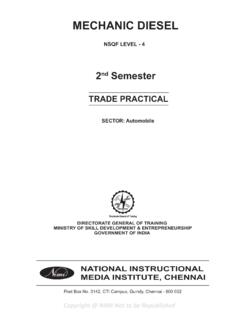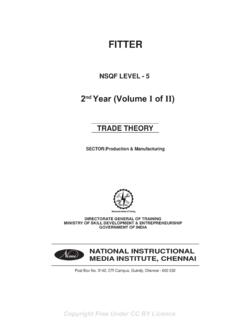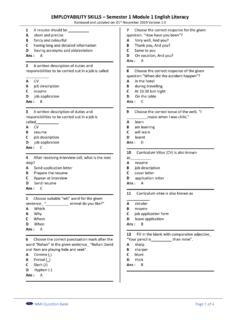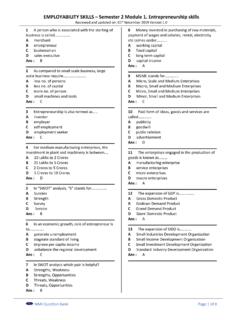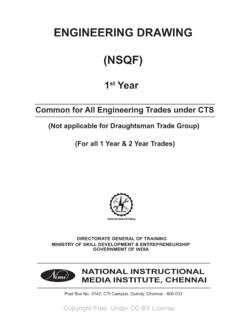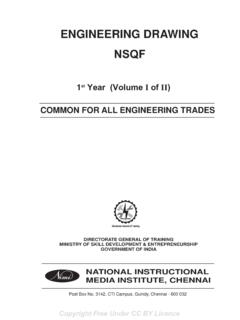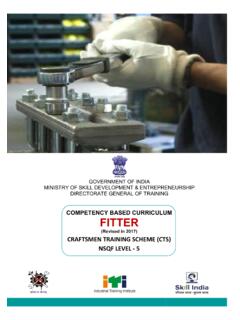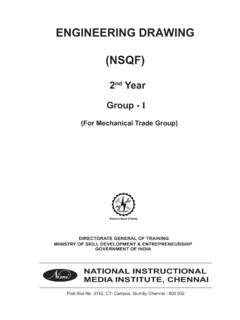Transcription of Electronic mech content. -Practical
1 (i)NATIONAL INSTRUCTIONALMEDIA INSTITUTE, CHENNAISECTOR: Electronics and HardwareTRADE PRACTICALPost Box No. 3142, CTI Campus, Guindy, Chennai - 600 0321st Year (Volume II of II) Electronic MECHANICDIRECTORATE GENERAL OF TRAININGMINISTRY OF SKILL DEVELOPMENT & ENTREPRENEURSHIPGOVERNMENT OF INDIANSQF LEVEL - 5 Copyright Free Under CC BY Licence(ii)Sector: Electronics & HardwareDuration : 2 - YearTrade: Electronic Mechanic 1st Year (Volume II of II) - Trade Practical - NSQF level 5 First EditionFirst Reprint : February 2019 Copies : 2,000 :November 2018 Copies : 1, All rights part of this publication can be reproduced or transmitted in any form or by any means, Electronic or mechanical, includingphotocopy, recording or any information storage and retrieval system, without permission in writing from the NationalInstructional Media Institute, by:NATIONAL INSTRUCTIONAL MEDIA INSTITUTEP.
2 B. , CTI Campus, Guindy Industrial Estate,Guindy, Chennai - 600 : 044 - 2250 0248, 2250 0657, 2250 2421 Fax : 91 - 44 - 2250 0791email : Free Under CC BY Licence(iii)FOREWORDThe government of I ndia has set an ambit ious target of imparting skills t o 30 crores people, one out of every four Indians, by 2020 to help them secure jobs as part of the National Skills Development Policy. Industrial Training Institutes (ITIs) play a vital role in this process especially in terms of providing skilled manpower. Keeping this in mind, and for providing the current industry relevant skill training to Trainees, ITI syllabus has been recently updated with t he help of Mentor Councils comprising various stakeholder's viz. I ndustries, Entrepreneurs, Academicians and representatives from National Instructional Media Institute (NIMI), Chennai, has now come up with instructional material to suit the revised curriculum for Electronic Mechanic 1st Year (Volume II of II) Trade Practical NSQF Level - 5 in Electronics & Hardware Sector under semester pattern.
3 The NSQF Level - 5 Trade Practical will help the trainees to get an international equivalency standard where their skill proficiency and competency will be duly recognized across the globe and this will also increase the scope of recognition of prior learning. NSQF Level - 5 trainees will also get the opportunities to promote life long learning and skill development. I have no doubt that with NSQF Level - 5 the trainers and trainees of ITIs, and all stakeholders will derive maximum benefits from these IMPs and that NIMI's effort will go a long way in improving the quality of Vocational training in the Executive Director & Staff of NIMI and members of Media Development Committee deserve appreciation for their contribution in bringing out this HindRAJESH AGGARWALD irector General/ Addl.
4 SecretaryMinistry of Skill Development & Entrepreneurship, government of india . New Delhi - 110 001 Copyright Free Under CC BY Licence(iv)PREFACEThe National Instructional Media Institute (NIMI) was established in 1986 at Chennai by then DirectorateGeneral of Employment and Training ( & T), ministry of labour and Employment, (now under DirectorateGeneral of Training, ministry of Skill Development and Entrepreneurship) government of india , with technicalassistance from the Govt. of the Federal Republic of Germany. The prime objective of this institute is todevelop and provide instructional materials for various trades as per the prescribed syllabi under the Craftsmanand Apprenticeship Training instructional materials are created keeping in mind, the main objective of Vocational Training underNCVT/NAC in india , which is to help an individual to master skills to do a job.
5 The instructional materials aregenerated in the form of Instructional Media Packages (IMPs). An IMP consists of Theory book, Practicalbook, Test and Assignment book, Instructor Guide, Audio Visual Aid (Wall charts and Transparencies) andot her support trade practical book consists of series of exercises to be completed by the trainees in the exercises are designed to ensure that all the skills in the prescribed syllabus are covered. The tradetheory book provides related theoretical knowledge required to enable the trainee to do a job. The test andassignments will enable the instructor to give assignments for the evaluation of the performance of a wall charts and transparencies are unique, as they not only help the instructor to effectively present atopic but also help him to assess the trainee's understanding.
6 The instructor guide enables the instructor toplan his schedule of instruction, plan the raw material requirements, day to day lessons and also deals with the complex skills required to be developed for effective team work. Necessary carehas also been taken to include important skill areas of allied trades as prescribed in the availability of a complete Instructional Media Package in an institute helps both the trainer andmanagement to impart effective IMPs are the outcome of collective effo rts of t he staff members of NIMI and the members of the MediaDevelopment Committees specially drawn from Public and Private sector industries, various training institutesunder the Directorate General of Training (DGT), government and Private would like to take this opportunity to convey sincere thanks to the Directors of Employment & Trainingof various State Governments, Training Departments of Industries both in the Public and Private sectors,Officers of DGT and DGT field institutes, proof readers, individual media developers and coordinators, but forwhose active support NIMI would not have been able to bring out this P.
7 DHINGRAROTCERID EVITUCEXE 230 006 - iannehCCopyright Free Under CC BY Licence(v)ACKNOWLEDGEMENTN ational Instructional Media Institute (NIMI) sincerely acknowledges with thanks for the co-operation andcontribution extended by the following Media Developers and their sponsoring organisations to bring out thisInstructional Material (Trade Practical) for the trade of Electronic Mechanic under Electronics and Hardwaresector for DEVELOPMENT COMMITTEE MEMBERSSmt. K. Arul selvi_Training officerNSTI (W), C. Anand_Vocational InstructorGovt. ITI for women, A. Jayaraman_Training officer (Retd.,)Govt. of india ,CTI, Krishnasamy_Vocational Instructor (Retd.,)Govt. of india ,VRC, S. Gopalakrishnan_Assistant Manager,Co-ordinator, NIMI, Chennai - records its appreciation for the Data Entry, CAD, DTP operators for their excellent and devoted services inthe process of development of this Instructional also acknowledges with thanks the invaluable efforts rendered by all other NIMI staff who have contributedtowards the development of this Instructional is also grateful to everyone who has directly or indirectly helped in developing this Instructional Free Under CC BY Licence(vi)INTRODUCTIONTRADE PRACTICALThe trade practical manual is intented to be used in workshop.
8 It consists of a series of practical exercies tobe completed by the trainees during the Second Semester course of the Electronic Mechanic Tradesupplemented and supported by instructions/ informations to assist in performing the exercises. Theseexercises are designed to ensure that all the skills in compliance with NSQF Level-5 prescribed syllabus manual is divided into ten modules. The distribution of time for the practical in the ten modules are 1 Transistor Amplifier75 HrsModule 2 Oscillators25 HrsModule 3 Wave shaping circuits25 HrsModule 4 Power Electronic components50 HrsModule 5 MOSFET & IGBT25 HrsModule 6 Opto-Electronics25 HrsModule 7 Basic Gates, Combinational circuits,Flip Flops75 HrsModule 8 Electronic Circuit Simulator50 HrsModule 9 Counter & Shift Registers75 HrsModule 10Op - Amp & Timer 555 Applications100 HrsProject work 50 Hrs Total575 HrsThe skill training in the computer lab is planned through a series of practical exercises centred around somepractical project.
9 However, there are few instance where the individual exercise does not form a part of developing the practical manual a sincere effort was made to prepare each exercise which will be easyto understand and carry out even by below average traninee. However the development team accept that thereis a scope for further improvement. NIMI, looks forward to the suggestions from the experienced training facultyfor improving the THEORYThe manual of trade theory consists of theoretical information for the First Semester couse of the ElectronicMechanic Trade. The contents are sequenced according to the practical exercise contained in the manual onTrade practical. Attempt has been made to relate the theoretical aspects with the skill covered in each exerciseto the extent possible.
10 This co-relation is maintained to help the trainees to develop the perceptional capabilitiesfor performing the Trade Theory has to be taught and learnt along with the corresponding exercise contained in the manualon trade practical. The indicating about the corresponding practical exercise are given in every sheet of will be preferable to teach/learn the trade theory connected to each exercise atleast one class beforeperforming the related skills in the shop floor. The trade theory is to be treated as an integrated part of material is not the purpose of self learning and should be considered as supplementary to class Free Under CC BY Licence(vii)Exercise of the Exercise Page 1: Transistor different transistors with respect to different package type,B-E-C pins, power, switching transistor, heatsink the condition of a given transistor using and Plot input and output characteristics of a transistor CE and test a transistor based switching circuit to control a relay(use relays of different coil voltages and transistors of different ) and test fixed bias, emitter bias, and voltage divider biastransistor and test a CE amplifier with and without emitter bypass and test a Common Base and test a Common Collector/Emitter Follower and test a Darlington and a two stage test RC-coupled and test class-B complementary push-pull and test Calss C Tuned Amplifier33 Module 2.
